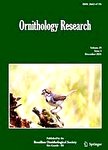版权所有:内蒙古大学图书馆 技术提供:维普资讯• 智图
内蒙古自治区呼和浩特市赛罕区大学西街235号 邮编: 010021

作者机构:Fac Ciencias Nat & Museo Div Zool Vertebrados Secc Ornitol Paseo Bosque S-NB1900FWA La Plata Buenos Aires Argentina Consejo Nacl Invest Cient & Tecn Paseo Bosque S-NB1900FWA La Plata Buenos Aires Argentina
出 版 物:《REVISTA BRASILEIRA DE ORNITOLOGIA》 (Rev. Bras. Ornitol.)
年 卷 期:2018年第26卷第2期
页 面:90-104页
核心收录:
学科分类:0710[理学-生物学] 07[理学] 071002[理学-动物学]
基 金:Consejo Nacional de Investigaciones Cientificas y Tecnicas (CONICET Ministerio de Ciencia y Tecnologia Argentina)
主 题:binomial mixture models classification trees generalized additive models generalized linear models mixed models occupancy models regression trees
摘 要:Studies on habitat use and habitat selection represent a basic aspect of bird ecology, due to its importance in natural history, distribution, response to environmental changes, management and conservation. Basically, a statistical model that identifies environmental variables linked to a species presence is searched for. In this sense, there is a wide array of analytical methods that identify important explanatory variables within a model, with higher explanatory and predictive power than classical regression approaches. However, some of these powerful models are not widespread in ornithological studies, partly because of their complex theory, and in some cases, difficulties on their implementation and interpretation. Here, I describe generalized linear models and other five statistical models for the analysis of bird habitat use and selection outperforming classical approaches: generalized additive models, mixed effects models, occupancy models, binomial N-mixture models and decision trees (classification and regression trees, bagging, random forests and boosting). Each of these models has its benefits and drawbacks, but major advantages include dealing with non-normal distributions (presence-absence and abundance data typically found in habitat use and selection studies), heterogeneous variances, non-linear and complex relationships among variables, lack of statistical independence and imperfect detection. To aid ornithologists in making use of the methods described, a readable description of each method is provided, as well as a flowchart along with some recommendations to help them decide the most appropriate analysis. The use of these models in ornithological studies is encouraged, given their huge potential as statistical tools in bird ecology.